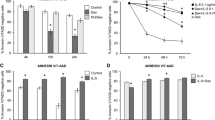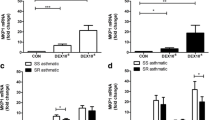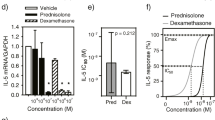Abstract
Glucocorticoids are effective drugs for eosinophil-related disorders, such as asthma and allergy. Previous studies have demonstrated that glucocorticoids increase eosinophil apoptosis and block the survival effect of submaximal concentrations of interleukin-5 (IL-5). We investigated the effect of glucocorticoids on eosinophil survival in the presence of a higher concentration of IL-5 (1 ng/ml), comparable to IL-5 levels in bronchoalveolar lavage and sputum specimens from patients with asthma. In contrast to incubation in the presence of submaximal concentrations of IL-5, the addition of dexamethasone (DEX) to media containing 1 ng/ml IL-5 led to a significant increase in eosinophil cell viability from 58 ± 6.9% to 87 ± 2.4% (p < 0.005) after 72 hours in culture. We found that RU486 blocked the DEX effect on cell viability confirming that glucocorticoid receptor functions are required. We investigated the possibility that the glucocorticoid enhancement of eosinophil survival may be due to an effect on IL-5 receptor expression. Our results show that the IL-5 associated decrease in IL-5 receptor α-subunit expression was blocked significantly after 24 hrs in culture with media containing IL-5 plus DEX compared to IL-5 alone. It is tempting to speculate that the observed glucocorticoid enhancement of eosinophil survival in the presence of elevated concentrations of IL-5 could be a mechanism that contributes to glucocorticoid resistance in asthma.
Similar content being viewed by others
References
Woolley KL, Gibson PG, Carty K, et al. Eosinophil apoptosis and the resolution of airway inflammation in asthma. Am J Respir Crit Care Med 1996; 154: 237–243.
Mehlhop PD, van de Rijn M, Goldberg AB, et al. Allergen-induced bronchial hyperreactivity and eosinophilic inflammation occur in the absence of IgE in a mouse model of asthma. Proc Natl Acad Sci USA 1997; 94: 1344–1349.
Pizzichini E, Pizzichini MM, Efthimiadis A, et al. Measuring airway inflammation in asthma: Eosinophils and eosinophilic cationic protein in induced sputum compared with peripheral blood. J Allergy Clin Immunol 1997; 99: 539–544.
Eum SY, Haile S, Lefort J, et al. Eosinophil recruitment into the respiratory epithelium following antigenic challenge in hyper-IgE mice is accompanied by interleukin 5-dependent bronchial hyperresponsiveness. Proc Natl Acad Sci USA 1995; 92: 12290–12294.
Lilly CM, Nakamura H, Kesselman H, et al. Expression of eotaxin by human lung epithelial cells: Induction by cytokines and inhibition by glucocorticoids. J Clin Invest 1997; 99: 1767–1773.
Ochiai K, Kagami M, Matsumura R, et al. IL-5 but not interferon-gamma (IFN-gamma) inhibits eosinophil apoptosis by up-regulation of bcl-2 expression. Clin Exp Immunol 1997; 107: 198–204.
Yamaguchi Y, Suda T, Ohta S, et al. Analysis of the survival of mature human eosinophils: interleukin-5 prevents apoptosis in mature human eosinophils. Blood 1991; 78: 2542–2547.
Yousefi S, Blaser K, Simon HU. Activation of signaling pathways and prevention of apoptosis by cytokines in eosinophils. Int Arch Allergy Immunol 1997; 112: 9–12.
Dewson G, Wardlaw AJ, Walsh GM. Human eosinophils: Apoptosis versus survival in the mediation of inflammation. Apop 1997; 1: 111–118.
Hallsworth MP, Litchfield TM, Lee TH. Glucocorticoids inhibit granulocyte-macrophage colony-stimulating factor-1 and interleukin-5 enhanced in vitro survival of human eosinophils. Immunology 1992; 75: 382–385.
Schleimer RP, Kaiser J, Tomioka K, et al. Studies on the mechanisms by which glucocorticoids inhibit tissue eosinophilia in allergic reachtions. Int Arch Allergy Immunol 1992; 99: 289–294.
Schleimer RP, Bochner BS. The effects of glucocorticoids on human eosinophils. J Allergy Clin Immunol 1994; 94: 1202–1213.
Savill J. Apoptosis in resolution of inflammation. J Leukoc Biol 1997; 61: 375–380.
Miesfeld RL, Bloom JW. Glucocorticoid receptor structure and function. In: Schleimer RP, Busse WW, O'Byrne PM, eds., Inhaled Steroids in Asthma, Vol. 97. New York: Marcel Dekker, Inc., 1997: 3–27.
Barnes PJ. Inhaled glucocorticoids for asthma. N Engl J Med 1995; 332: 868–875.
Barnes PJ. Mechanisms of action of glucocorticoids in asthma. Am J Respir Crit Care Med 1996; 154: S21–S26; discussion S6-S7.
Adkins KK, Levan TD, Miesfeld RL, et al. Glucocorticoid regulation of GM-CSF: Evidence for transcriptional mechanisms in airway epithelial cells. Am J Physiol 1998; 275: L372–L378.
Schwiebert LM, Stellato C, Schleimer RP. The epithelium as a target of glucocorticoid action in the treatment of asthma. Am J Respir Crit Care Med 1996; 154: S16–S19; discussion S9-S20.
Spahn JD, Landwehr LP, Nimmagadda S, et al. Effects of glucocorticoids on lymphocyte activation in patients with steroidsensitive and steroid-resistant asthma. J Allergy Clin Immunol 1996; 98: 1073–1079.
Wallen N, Kita H, Weiler D, et al. Glucocorticoids inhibit cytokine-mediated eosinophil survival. J Immunol 1991; 147: 3490–3495.
Meagher LC, Cousin JM, Seckl JR, et al. Opposing effects of glucocorticoids on the rate of apoptosis in neutrophilic and eosinophilic granulocytes. J Immunol 1996; 156: 4422–4428.
Miltenyi S, Muller W, Weichel W, et al. High gradient magnetic cell separation with MACS. Cytometry 1990; 11: 231–238.
Hansel TT, De Vries IJ, Iff T, et al. An improved immunomagnetic procedure for the isolation of highly purified human blood eosinophils. J Immunol Methods 1991; 145: 105–110.
McGahon AJ, Martin SJ, Bissonnette RP, et al. The end of the (cell) line: Methods for the study of apoptosis in vitro. Methods Cell Biol 1995; 46: 153–185.
Suzuki K, Kostin S, PersonV, et al. Time course of the apoptotic cascade and effects of caspase inhibitors in adult rat ventricular cardiomyocytes. J Mol Cell Cardiol 2001; 33: 983–994.
Takahashi A, Kono K, Amemiya H, et al. Elevated caspase-3 activity in peripheral blood T cells coexists with increased degree of T-cell apoptosis and down-regulation of TCR zeta molecules in patients with gastric cancer. Clin Cancer Res 2001; 7: 74–80.
Hagan JB, Kita H, Gleich GJ. Inhibition of interleukin-5 mediated eosinophil viability by fluticasone 17-propionate: Comparison with other glucocorticoids. Clin Exp Allergy 1998; 28: 999–1006.
Stellato C, Atsuta J, Bickel CA, et al. An in vitro comparison of commonly used topical glucocorticoid preparations. J Allergy Clin Immunol 1999; 104: 623–629.
Pizzichini MM, Pizzichini E, Clelland L, et al. Sputum in severe exacerbations of asthma: Kinetics of inflammatory indices after prednisone treatment. Am J Respir Crit Care Med 1997; 155: 1501–1508.
Sur S, Gleich GJ, Swanson MC, et al. Eosinophilic inflammation is associated with elevation of interleukin-5 in the airways of patients with spontaneous symptomatic asthma. J Allergy Clin Immunol 1995; 96: 661–668.
Tillie-Leblond I, Hammad H, Desurmont S, et al. CC chemokines and interleukin-5 in bronchial lavage fluid from patients with status asthmaticus. Potential implication in eosinophil recruitment. Am J Respir Crit Care Med 2000; 162: 586–592.
Lopez AF, Elliott MJ, Woodcock J, et al. GM-CSF, IL-3 and IL-5: Cross-competition on human haemopoietic cells. Immunol Today 1992; 13: 495–500.
Gregory B, Kirchem A, Phipps S, et al. Differential regulation of human eosinophil IL-3, IL-5, and GM-CSF receptor alpha-chain expression by cytokines: IL-3, IL-5, and GM-CSF down-regulate IL-5 receptor alpha expression with loss of IL-5 responsiveness, but up-regulate IL-3 receptor alpha expression. J Immunol 2003; 170: 5359–5366.
Wang P, Wu P, Cheewatrakoolpong B, et al. Selective inhibition of IL-5 receptor alpha-chain gene transcription by IL-5, IL-3, and granulocyte-macrophage colony-stimulating factor in human blood eosinophils. J Immunol 1998; 160: 4427–4432.
Liu LY, Sedgwick JB, Bates ME, et al. Decreased expression of membrane IL-5 receptor alpha on human eosinophils: II. IL-5 down-modulates its receptor via a proteinase-mediated process. J Immunol 2002; 169: 6459–6466.
Wiegers GJ, Reul JM. Induction of cytokine receptors by glucocorticoids: Functional and pathological significance. Trends Pharmacol Sci 1998; 19: 317–321.
Franchimont D, Galon J, Vacchio MS, et al. Positive effects of glucocorticoids on T cell function by up-regulation of IL-7 receptor alpha. J Immunol 2002; 168: 2212–2218.
Wedi B, Raap U, Lewrick H, et al. Delayed eosinophil programmed cell death in vitro: A common feature of inhalant allergy and extrinsic and intrinsic atopic dermatitis. J Allergy Clin Immunol 1997; 100: 536–543.
Author information
Authors and Affiliations
Corresponding author
Rights and permissions
About this article
Cite this article
Bloom, J.W., Chacko, J., Lohman, I.C. et al. Differential control of eosinophil survival by glucocorticoids. Apoptosis 9, 97–104 (2004). https://doi.org/10.1023/B:APPT.0000012126.06126.c4
Issue Date:
DOI: https://doi.org/10.1023/B:APPT.0000012126.06126.c4




